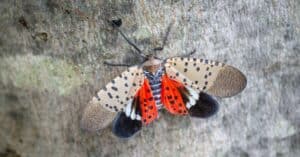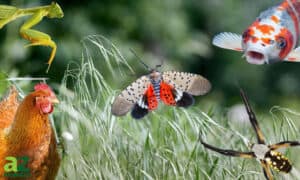Key Points
- A spotted lanternfly is an invasive plant-hopping insect that eats or lays eggs on nearly 200 plant species in the United States alone, including pine, apple, plum, cherry, and peach trees.
- Several lanternfly traps are built to catch nymphs, young lanternflies with underdeveloped wings, as they are climbing the trunks of trees after having been blown off by the wind.
- To build your own homemade collection container lanternfly trap, you’ll need a clean, empty plastic jar, plus a window screen, wood, wire, plastic milk jugs, duct tape, hot glue, staples, zip ties, and twine or a similar cord.
- It is not recommended to use glue traps as these kill beneficial insects, birds, and bats just as often as they trap lanternflies.
If you spend any time in the woods, you will begin to see that a vast number of trees are dying out. We have already lost the American Chestnut and the Elm tree. Currently, the emerald ash borer is killing off Ash trees, there is a fungus or parasite that kills mature Beech trees. Hard Maple are dying at an alarming rate for reasons no one fully understands. Hemlock are being threatened by a parasite. Our forests are in grave danger and the spotted lantern fly is yet another invader piling on to damage our trees.
You may have seen these strange-looking insect in the northeastern United States. Have you heard the call to destroy spotted lanternflies on sight? Have you wondered why this innocent-looking bug has such a bad reputation? What are spotted lanternflies? Where do they live, and how can you identify them? Find the answers to these questions, and learn how to build the best type of spotted lanternfly trap.
What Is a Spotted Lanternfly?
According to PennState Extension, “The spotted lanternfly (SLF) is an invasive insect that feeds on grapevines and trees.” It is a type of jumping insect known as a planthopper.
What Do Spotted Lanternflies Look Like?
The spotted lanternfly is small, about 1 inch long, and resembles a moth when its wings are open. As its name suggests, it has black spots on its grey to reddish wings. The wingtips are also black or mottled, and the rear wings have a splash of bright red. Adults can also jump long distances.
The nymphs or mature form of the spotted lanternfly also have spots. The weevil or beetle-like insects may be black or black and red with white spots. This unique coloration makes them easily recognizable.
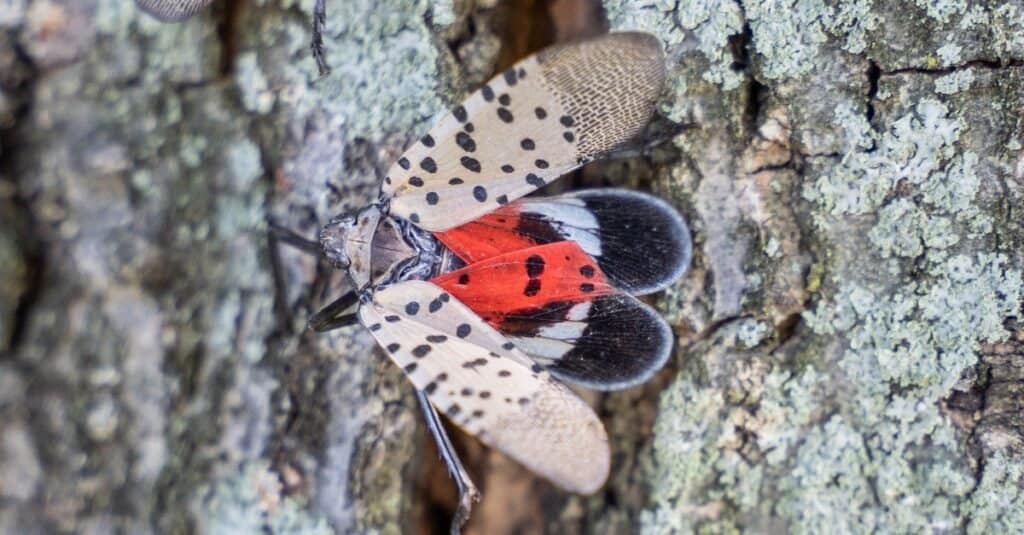
©Amy Lutz/Shutterstock.com
Where Do Spotted Lanternflies Live?
Spotted lanternflies originated in Asia, where they are an important part of their native ecosystems in Vietnam, India, and China. They have been found in Pennsylvania, USA, since 2014. They have also been detected in New York, New Jersey, Maryland, Delaware, Connecticut, Virginia, and West Virginia. Efforts have been made to control their spread, but they may soon be found in other New England states. Japan and South Korea are also battling this invasive species.
Why Trap a Spotted Lanternfly?
Spotted lanternflies can be damaging to certain plants. This is especially a problem when the trees or grapevines are cultivated for commercial use. In fact, it eats or lays eggs on nearly 200 North American plant species, including pine, apple, plum, cherry, and peach trees. Though they do not bite, groupings of insects can also be a nuisance to people.
Spotted lanternfly infestations can damage or kill plants. They eat sap from the trees, leaving wounds that can become infected. The sugary excrement of the nymphs can also invite sooty mold to grow on the host plant. Grapevines attacked by these insects typically produce no fruit.
Some management systems employ insecticides to kill spotted lanternflies, but this poses an additional problem. Insecticides also kill beneficial bugs, like bees and predatory insects that feed on pests. Using a trap is an effective way to reduce spotted lanternfly populations with minimal impact on other species.
A dish soap spray is a safer alternative to pesticides. Mix equal parts water and dish soap in a spray bottle, and mist adults, nymphs, or eggs. The mixture kills spotted lanternflies on contact but is safe for people, pets, and most plants.
How a Spotted Lanternfly Trap Works
Immature lanternflies, known as nymphs, often feed in the tree canopy. If they are blown out by the wind, the still-flightless insects march up the trunks of trees to return to the upper branches. Several types of traps take advantage of this behavior by capturing nymphs on their upward climb.
One trap type is a sticky band placed horizontally around the tree trunk. This method is effective at halting the nymphs, but unfortunately, it can also capture other insects and even small reptiles and birds. A metal mesh can be placed around the band that allows the nymphs to pass through while keeping larger creatures out. This trap style is generally not recommended.
The second type of trap is known as a circle weevil trap. It is so named because it was originally designed to catch pecan weevils, which also walk up trees. Circle traps consist of a tunnel of insect screening that the insects walk into and a collection container that creates a dead-end. These types of traps can be purchased commercially, or you can easily make your own. It is considered the best option for trapping lanternflies.
Next, we’ll consider the materials needed and the steps involved in creating a lanternfly circle trap.
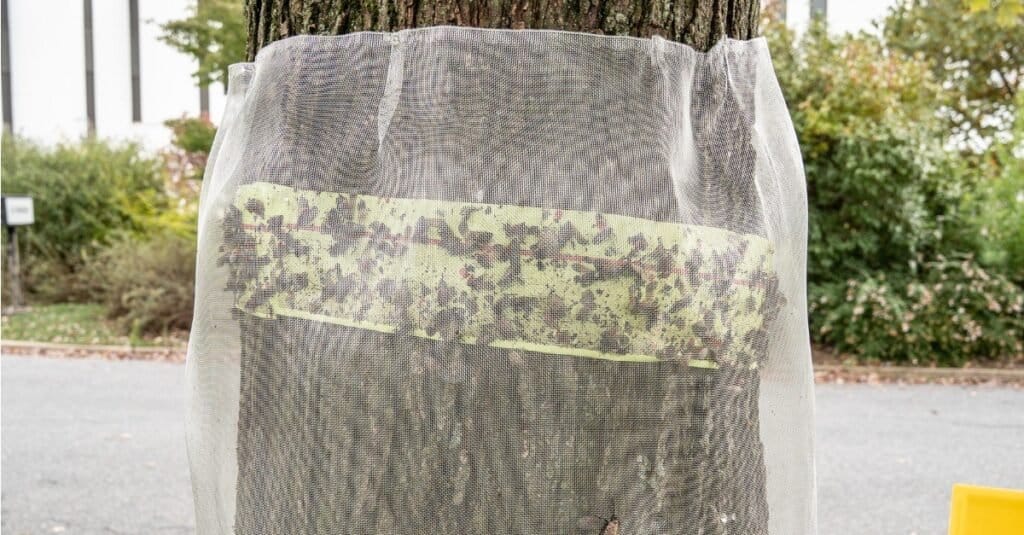
Sticky tape is used to trap lanternflies. This is covered in netting to prevent birds from getting harmed.
©iStock.com/arlutz73
How to Build a Spotted Lanternfly Trap
Lanternfly traps can be purchased commercially, or you can build your own. Here’s what you’ll need for DIY.
Spotted Lanternfly Trap Materials: What You’ll Need to Build the Best Spotted Lanternfly Trap
For the collection container, you can use a clean peanut butter or mayonnaise jar, or a large plastic Ziploc-style bag. The bag option makes for easier cleanup, as you can seal it and toss it, rather than emptying dead, stinky bugs from a jar into a trash receptacle. It also bends, allowing the captured insects to fall into a corner. This keeps the entryway of the trap from becoming clogged.
Make sure that the jar or bag you choose is clear and not tinted, as the insects tend to move upward, toward the light. Dirty or opaque containers will stifle this behavior.
You will also need a window screen, wood, wire, plastic milk jugs, duct tape, hot glue, staples, zip ties, and twine or a similar cord. The screen should be a rectangle around 2 to 3 ft. If placing your trap on a very large tree, you may need more. Some people report that a plastic-coated screen works better than a bare wire screen. For the wood, you may use readily available materials, such as yardsticks or paint stirrers.
Step 1: Make a Funnel
Cut the tops from the plastic milk jugs and attach them to one another, with the spouts facing inward and the cut edges facing outward. Put a bead of hot glue around the joint and then secure with duct tape. The result should be a double-sided funnel.
Step 2: Attach the Screen
Cut a small half-circle-shaped notch from the top edge of the window or insect screening. This semicircle should be about 1 inch long. Then, attach the screening to one opening of your funnel. Use the notch to work the material around until it covers the inside of the funnel and overlaps on the edges. Secure it with hot glue. Be patient – allow the glue to dry as you work. Then, attach it to the bottom edge of the funnel using hot glue.
Step 3: Build the Supports
Cut one piece of wood to a length of 18 inches. Staple it to the bottom of the funnel, within the mesh. Then, staple the mesh to the wood.
Draw the ends of the mesh together to create the “tunnel.” Secure the ends to a smaller piece of wood, about 12 inches in length.
Then, make a large “U” shape with the wire. Attach it to the bottom of the mesh, centering the shorter piece of wood above it and opposite the longer piece of wood. Depending on the wire, you might weave it through the mesh or secure it with staples.
Step 4: Set the Trap
Attach your trap to the tree. Tie the funnel of the trap to the tree using twine or cord. Avoid using nails or screws, as these will damage the tissue of the tree.
Secure the non-wired half of the screen to the trunk, with the longer piece of wood braced against the trunk. You can use cord or push pins to do this. The mesh should be flat against the tree so that the insects may crawl onto it and not under it.
Arrange the wire so that it pushes the side of the trap with the short piece of wood away from the tree, forming the tunnel.
Step 5: Assemble the Collection Container
Set up a collection container on the top of the funnel. If using a jar, deform the funnel so that it slides inside the mouth of the jar, then seal the opening with tape.
If using a plastic bag, slit one corner so that it will fit over the funnel. Cinch it tight using a zip tie. Make sure the zippered side is firmly closed.
Step 6: Check Your Trap
Remember to check and empty your trap often, even daily. Why? A full trap will become clogged and you will not catch any additional spotted lanternflies. Also, the dead insects will soon begin to rot and stink if the trap is not emptied.
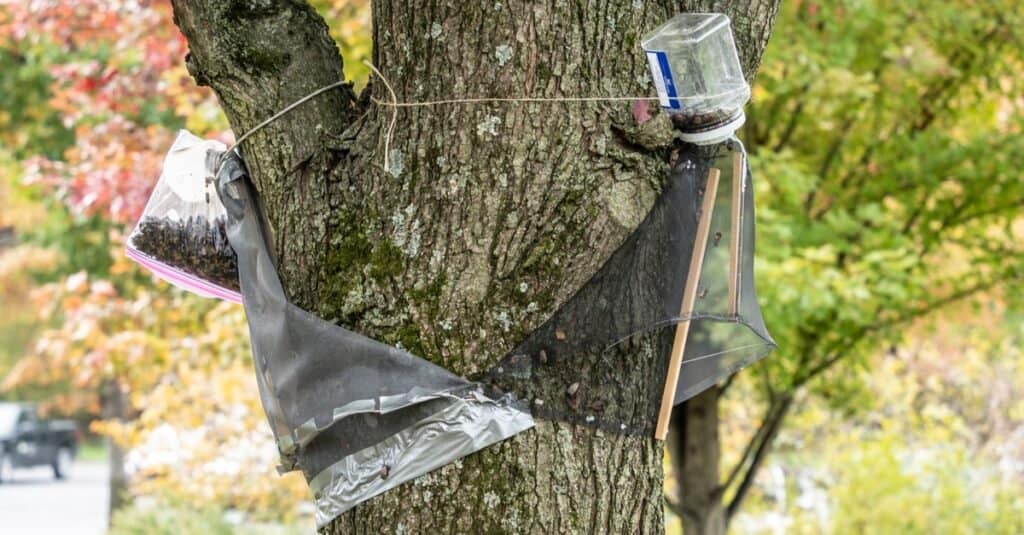
©iStock.com/arlutz73
Where Should I Place My Trap?
You can attach the trap to any tree infested with spotted lanternflies. Walnut, willow, and tree of heaven are often hosts to these insects. Try to select trees with smooth bark. Trees with rough or deeply grooved bark are not good candidates, as the nymphs will walk through the bark furrows under the trap!
Do Spotted Lanternfly Traps Work?
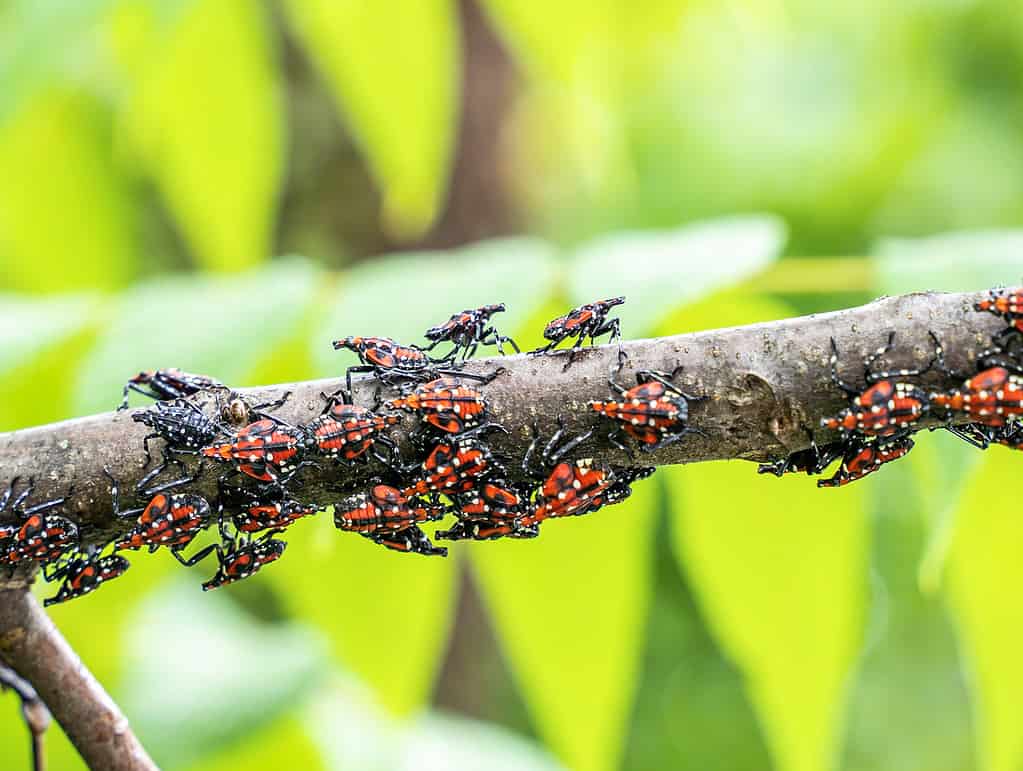
Black nymphs can be seen as early as April and up to July while red nymphs can be seen from July until September.
©iStock.com/arlutz73
The two most commonly used traps to catch spotted lantern flies are very effective, not only against adult flies but more specifically against the nymphs as they move up and down and between plants. However, the trap preferred is the circle trap as it can greatly reduce the chances of capturing other creatures. The circle trap acts like a tunnel that the lantern flies walk into and will end up in a collection container where they will be unable to escape, eventually dying.
It is recommended that trapping should be done on host trees that are used during the early season, where nymphs are commonly found in large quantities, although they can also be found on other plants, from raspberry and rose bushes to apple, oak, and pine trees. Black nymphs can be seen as early as April and up to July; Red nymphs can be seen from July until September and adults begin to appear as early as July. Traps are effective for both nymphs and adults as well, but as adults do not move up and down trees and plants as much, they aren’t as effective.
Preventing Spotted Lanternflies
Spotted lanternflies can hitchhike on plants, building or landscape materials, or outdoor furniture obtained from infested areas. Inspect materials and wash them with dish soap if possible to remove and kill nymphs and eggs.
Another tip for getting rid of them is to make a homemade spray using natural ingredients that are repellent to them like rubbing alcohol, vinegar, and water, or cider vinegar and dish soap. Certain scents also repel them like oil of lavender, spearmint or peppermint oils, tea tree oil, and rosemary.
The photo featured at the top of this post is ©
Thank you for reading! Have some feedback for us? Contact the AZ Animals editorial team.



